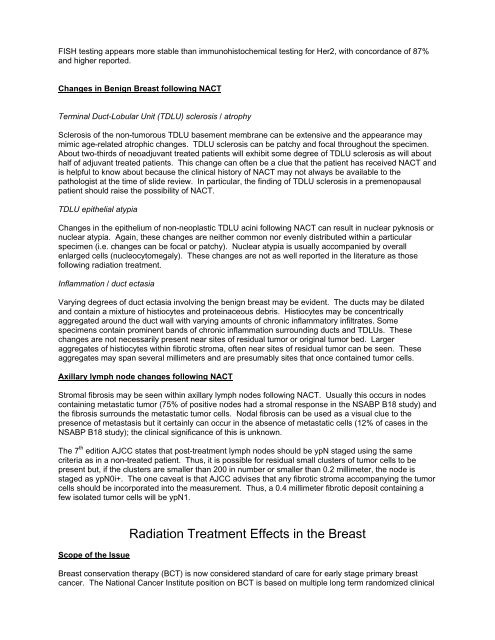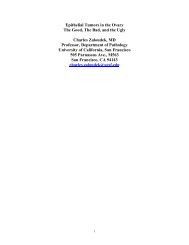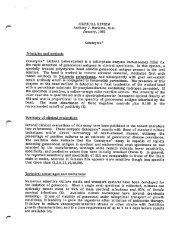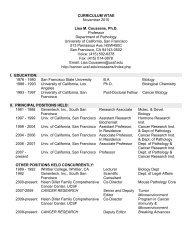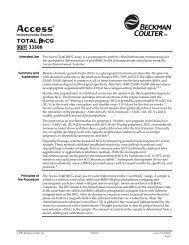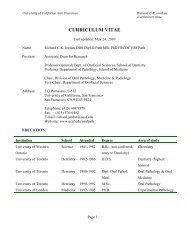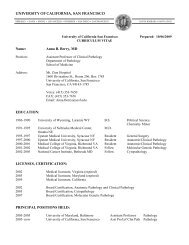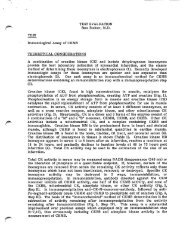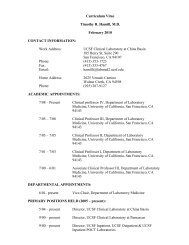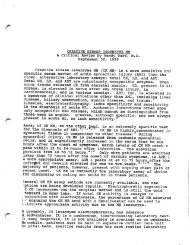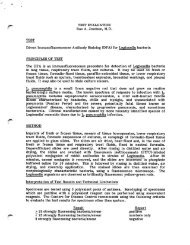Treatment Induced Changes in the Breast: Diagnosis and Staging of ...
Treatment Induced Changes in the Breast: Diagnosis and Staging of ...
Treatment Induced Changes in the Breast: Diagnosis and Staging of ...
You also want an ePaper? Increase the reach of your titles
YUMPU automatically turns print PDFs into web optimized ePapers that Google loves.
FISH test<strong>in</strong>g appears more stable than immunohistochemical test<strong>in</strong>g for Her2, with concordance <strong>of</strong> 87%<br />
<strong>and</strong> higher reported.<br />
<strong>Changes</strong> <strong>in</strong> Benign <strong>Breast</strong> follow<strong>in</strong>g NACT<br />
Term<strong>in</strong>al Duct-Lobular Unit (TDLU) sclerosis / atrophy<br />
Sclerosis <strong>of</strong> <strong>the</strong> non-tumorous TDLU basement membrane can be extensive <strong>and</strong> <strong>the</strong> appearance may<br />
mimic age-related atrophic changes. TDLU sclerosis can be patchy <strong>and</strong> focal throughout <strong>the</strong> specimen.<br />
About two-thirds <strong>of</strong> neoadjuvant treated patients will exhibit some degree <strong>of</strong> TDLU sclerosis as will about<br />
half <strong>of</strong> adjuvant treated patients. This change can <strong>of</strong>ten be a clue that <strong>the</strong> patient has received NACT <strong>and</strong><br />
is helpful to know about because <strong>the</strong> cl<strong>in</strong>ical history <strong>of</strong> NACT may not always be available to <strong>the</strong><br />
pathologist at <strong>the</strong> time <strong>of</strong> slide review. In particular, <strong>the</strong> f<strong>in</strong>d<strong>in</strong>g <strong>of</strong> TDLU sclerosis <strong>in</strong> a premenopausal<br />
patient should raise <strong>the</strong> possibility <strong>of</strong> NACT.<br />
TDLU epi<strong>the</strong>lial atypia<br />
<strong>Changes</strong> <strong>in</strong> <strong>the</strong> epi<strong>the</strong>lium <strong>of</strong> non-neoplastic TDLU ac<strong>in</strong>i follow<strong>in</strong>g NACT can result <strong>in</strong> nuclear pyknosis or<br />
nuclear atypia. Aga<strong>in</strong>, <strong>the</strong>se changes are nei<strong>the</strong>r common nor evenly distributed with<strong>in</strong> a particular<br />
specimen (i.e. changes can be focal or patchy). Nuclear atypia is usually accompanied by overall<br />
enlarged cells (nucleocytomegaly). These changes are not as well reported <strong>in</strong> <strong>the</strong> literature as those<br />
follow<strong>in</strong>g radiation treatment.<br />
Inflammation / duct ectasia<br />
Vary<strong>in</strong>g degrees <strong>of</strong> duct ectasia <strong>in</strong>volv<strong>in</strong>g <strong>the</strong> benign breast may be evident. The ducts may be dilated<br />
<strong>and</strong> conta<strong>in</strong> a mixture <strong>of</strong> histiocytes <strong>and</strong> prote<strong>in</strong>aceous debris. Histiocytes may be concentrically<br />
aggregated around <strong>the</strong> duct wall with vary<strong>in</strong>g amounts <strong>of</strong> chronic <strong>in</strong>flammatory <strong>in</strong>filtrates. Some<br />
specimens conta<strong>in</strong> prom<strong>in</strong>ent b<strong>and</strong>s <strong>of</strong> chronic <strong>in</strong>flammation surround<strong>in</strong>g ducts <strong>and</strong> TDLUs. These<br />
changes are not necessarily present near sites <strong>of</strong> residual tumor or orig<strong>in</strong>al tumor bed. Larger<br />
aggregates <strong>of</strong> histiocytes with<strong>in</strong> fibrotic stroma, <strong>of</strong>ten near sites <strong>of</strong> residual tumor can be seen. These<br />
aggregates may span several millimeters <strong>and</strong> are presumably sites that once conta<strong>in</strong>ed tumor cells.<br />
Axillary lymph node changes follow<strong>in</strong>g NACT<br />
Stromal fibrosis may be seen with<strong>in</strong> axillary lymph nodes follow<strong>in</strong>g NACT. Usually this occurs <strong>in</strong> nodes<br />
conta<strong>in</strong><strong>in</strong>g metastatic tumor (75% <strong>of</strong> positive nodes had a stromal response <strong>in</strong> <strong>the</strong> NSABP B18 study) <strong>and</strong><br />
<strong>the</strong> fibrosis surrounds <strong>the</strong> metastatic tumor cells. Nodal fibrosis can be used as a visual clue to <strong>the</strong><br />
presence <strong>of</strong> metastasis but it certa<strong>in</strong>ly can occur <strong>in</strong> <strong>the</strong> absence <strong>of</strong> metastatic cells (12% <strong>of</strong> cases <strong>in</strong> <strong>the</strong><br />
NSABP B18 study); <strong>the</strong> cl<strong>in</strong>ical significance <strong>of</strong> this is unknown.<br />
The 7 th edition AJCC states that post-treatment lymph nodes should be ypN staged us<strong>in</strong>g <strong>the</strong> same<br />
criteria as <strong>in</strong> a non-treated patient. Thus, it is possible for residual small clusters <strong>of</strong> tumor cells to be<br />
present but, if <strong>the</strong> clusters are smaller than 200 <strong>in</strong> number or smaller than 0.2 millimeter, <strong>the</strong> node is<br />
staged as ypN0i+. The one caveat is that AJCC advises that any fibrotic stroma accompany<strong>in</strong>g <strong>the</strong> tumor<br />
cells should be <strong>in</strong>corporated <strong>in</strong>to <strong>the</strong> measurement. Thus, a 0.4 millimeter fibrotic deposit conta<strong>in</strong><strong>in</strong>g a<br />
few isolated tumor cells will be ypN1.<br />
Scope <strong>of</strong> <strong>the</strong> Issue<br />
Radiation <strong>Treatment</strong> Effects <strong>in</strong> <strong>the</strong> <strong>Breast</strong><br />
<strong>Breast</strong> conservation <strong>the</strong>rapy (BCT) is now considered st<strong>and</strong>ard <strong>of</strong> care for early stage primary breast<br />
cancer. The National Cancer Institute position on BCT is based on multiple long term r<strong>and</strong>omized cl<strong>in</strong>ical


